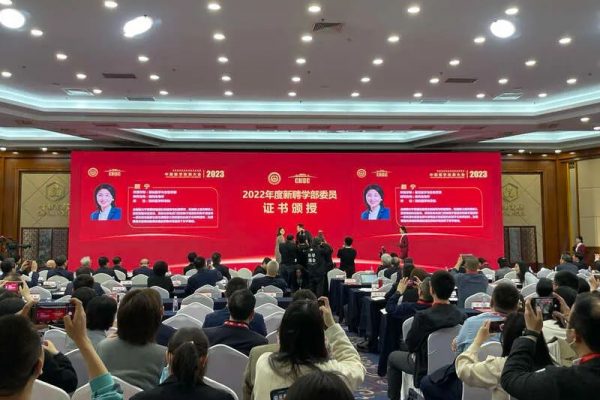Chip发表复旦大学熊诗圣、肖晓团队最新研究成果:用于侵入式神经信号记录的多层柔性流苏探针
FUTURE远见| 2022-09-30
Future|远见
Future|远见future选编
研究团队制备了一种多层柔性流苏神经探针,该探针由低成本、可快速迭代的激光直写光刻工艺制备而成,显著提高了设计和制造的灵活性,而且多层的结构使得探针可以于纵深方向上排布更多的记录位点,在不增大植入体积的情况下记录到更广范围内的神经信号。结合封装工艺和模拟前端信号处理电路,研究团队成功将探针用于小鼠的内侧前额叶皮层的单神经元放电信号的记录之中,展示了探针的实用性。
图1 | 多层柔性流苏神经探针植入系统的整体示意图。主体部分主要由3个部分构成:1)OMNETICS 连接器,2)印刷电路板(PCB)和柔性印刷电路板(FPC),3)神经探针器件。其中神经探针与FPC之间通过wire-bonding的方式连接。图中标尺:3 mm。
柔性神经探针由于能够降低植入时的脑组织损伤,有效减小电极与组织界面的微运动而成为目前的研究热点²⁻³,而在众多柔性探针与对应的辅助植入方案之中,流苏型的探针结构设计搭配聚乙二醇(PEG)增强可以在保持尽可能小植入创面的同时,避免额外装置的引入,减少整体工作的复杂程度⁴⁻⁵。
图2 | 多层柔性流苏神经探针器件部分的光学显微镜照片a-c、扫描电子显微镜照片d、e与结构示意图f。图a-b标尺分别为100 μm、50 μm、50 μm,图d、e标尺分别为40 μm、8 μm。
研究团队提出了一种利用低成本无掩模激光直写光刻工艺制造多层柔性流苏型神经探针的方法,并结合简单的组装模式来制备整个植入系统。该探针有32个记录电极,分布在16个相互分立的电极细丝上,纵向上排列成两排,用于记录不同深度的神经元放电信号,单个电极记录位点的面积约为8 × 8平方微米。材料方面,使用聚酰亚胺作为探针的基底与绝缘层,金作为导电层,并且采用了简单的电镀金方式来进一步减小电极阻抗,电镀后记录位点在1000 Hz的测试频率下的平均阻抗约为0.27 MΩ。探针的主体结构制备完成后,使用PEG浸涂的方式增强机械性能,此时探针的16根分立电极细丝聚拢成一束,植入体的总直径小于50 μm,机械性能测试也证明其具有植入脑组织所需的刚度。探针通过wire-bonding的方式与定制的PCB/FPC相连,接入后端的信号处理模块。最终植入系统被用于小鼠的内侧前额叶皮层的单神经元放电信号的记录。
研究团队在多层柔性神经探针的基础上设计并制造了配套的无线闭环光遗传电路模块,该模块集信号预处理、数据无线传输、基于光纤的光遗传刺激控制等功能于一体,在未来将用于光遗传等领域的研究。
A tassel-type multilayer flexible probe for invasive neural recording¹
Flexible neural probes have become a current research hotspot because they can effectively reduce the micro-motion at the electrode/tissue interface and the brain tissue damage caused during or after implantation²⁻³. Among all kinds of flexible probes, the tassel-type probe with polyethylene glycol (PEG) enhancement can keep the implantation wound as small as possible, avoid the introduction of additional devices, and reduce the complexity of the overall work⁴⁻⁵.
In this work, the research team prepared a tassel-type multilayer flexible neural probe. The multi-layer structure allowed the probe to arrange more recording sites in the vertical direction to record a wider range of neural signals without increasing the implant size. The research team successfully recorded the spike signals in the medial prefrontal cortex of mice, demonstrating the practicality of the probe.
The research team proposed a method to fabricate a tassel-type multilayer flexible neural probe using a low-cost maskless laser direct writing lithography process (which ensures design flexibility), combined with a simple assembly mode to fabricate the entire implant system. The probe has 32 recording electrodes, distributed on 16 separate electrode filaments, arranged in two rows longitudinally, and used to record neural signals at different depths. The area of a single electrode recording site is about 8 × 8 μm². In terms of materials, polyimide is used as the substrate and insulating layer, gold is used as the conductive layer, and a simple gold electroplating method is used to further reduce the electrode impedance. After electroplating, the mean impedance of recording sites at a test frequency of 1000 Hz is about 0.27 MΩ. After the main fabrication process, the probe is coated with PEG to enhance mechanical properties, and the 16 discrete electrode filaments are gathered into a bundle, of which the total diameter is less than 50 μm. Mechanical testing also demonstrated that the probe has the necessary stiffness to implant in brain tissue. The probe is connected to customized printed circuit boards and flexible printed circuits (PCB/FPC) by wire-bonding and is connected to the back-end signal processing equipment.
The research team also designed and manufactured a wireless closed-loop optogenetic circuit based on the multilayer flexible neural probe, which integrates signal preprocessing units, wireless data transmission units, and optical fiber-based optogenetic stimulation control units. The whole system will be employed to conduct further optogenetics research in the future.
参考文献
[1]Ye, Z.-P. et al. A tassel-type multilayer flexible probe for invasive neural recording. Chip 1, 100024 (2022).
[2]Du, Z. J. et al. Ultrasoft microwire neural electrodes improve chronic tissue integration. Acta Biomater. 53, 46-58 (2017).
[3]Yang, X. et al. Bioinspired neuron-like electronics. Nat. Mater. 18, 510-517 (2019).
[4]Guan, S. et al. Elastocapillary self-assembled neurotassels for stable neural activity recordings. Sci. Adv. 5, eaav2842 (2019).
[5]Zou, L. et al. Self-assembled multifunctional neural probes for precise integration of optogenetics and electrophysiology. Nat. Commun. 12, 5871 (2021).
论文链接:
https://www.sciencedirect.com/science/article/pii/S2709472322000223
关于Chip
Chip是全球唯一聚焦芯片类研究的综合性国际期刊,已入选由中国科协、教育部、科技部、中科院等单位联合实施的「中国科技期刊卓越行动计划高起点新刊项目」,为科技部鼓励发表「三类高质量论文」期刊之一。
Chip期刊由上海交通大学与Elsevier集团合作出版,并与多家国内外知名学术组织展开合作,为学术会议提供高质量交流平台。
Chip秉承创刊理念: All About Chip,聚焦芯片,兼容并包,旨在发表与芯片相关的各科研领域尖端突破性成果,助力未来芯片科技发展。迄今为止,Chip已在其编委会汇集了来自13个国家的68名世界知名专家学者,其中包括多名中外院士及IEEE、ACM、Optica等知名国际学会终身会士(Fellow)。
Chip第三期将于2022年9月在爱思唯尔Chip官网以金色开放获取形式(Gold Open Access)发布,欢迎访问阅读文章。
爱思唯尔Chip官网:
https://www.journals.elsevier.com/chip
Warning: Invalid argument supplied for foreach() in /www/wwwroot/www.futureyuanjian.com/wp-content/themes/future/single-news.php on line 41



